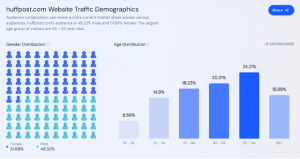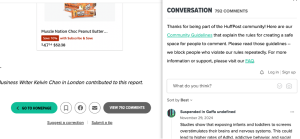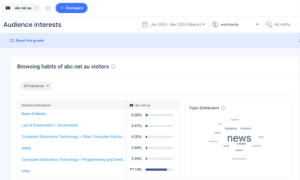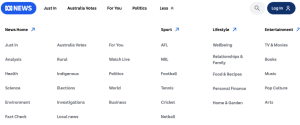Introduction
This article compares the HuffPost and ABC News’ coverage of Australia’s under-16s social media ban, exploring the differences in writing, online and technical delivery between the two outlets, highlighting the strengths and weaknesses of both outlets in the online journalism space.
News story 1: Reporting on Australia’s social media ban on teenagers (Huff Post)
Biographical Section
HuffPost is a digital news platform. According to HuffPost’s About Us, the website was founded by Arianna Huffington and others in 2005. It became famous for its strategy of creating news stories mainly through search engine optimization (SEO) and popular keywords. In 2018, it stopped accepting unpaid articles and created content by a professional news editing team. In addition, news content from well-known platforms such as the Associated Press (AP) will be reprinted.
HuffPost mainly relies on advertising and social media, including news and user-generated content through video blogs, audio, and photos. According to Cherubini (2016), HuffPost integrates audience data into editorial decisions and uses testing tools to send out articles in two different versions to select the more popular articles.
According to similarweb.com in February 2025, The HuffPost has an evenly distributed audience, with about 52% female and 48% male. The chart shows that the audience is mostly in the 55-64 age group, followed by 45-54. Most of the site’s traffic comes from the United States (88.95%), followed by Canada and Australia.


Writing and content production
This news lacks authoritative sources. According to Bradshaw (2023), telling a basic news story requires using links and embedded media to provide additional context. The entire article relies only on information from the Meta platform and quotations from some public figures. Although these voices add a certain degree of credibility, they do not provide authoritative government reports or real legislative documents, which limits the credibility of the article.
![]()

The language of news is simple, and suitable for readers to read quickly. The use of attractive words in the title arouses readers’ interest in reading, especially the word “World First Law”, which emphasizes the impact of this policy. Kulkarni (2023) argues that Online journalists need to use expressions that are suitable for modern times. Compared with traditional news, a humorous tone can convey information more effectively.

The article consists of short paragraphs with a simple structure and is easy to browse on mobile devices. However, the structure of the article is not clear, and there is a lack of subheadings, which cannot clearly tell readers the specific news points of the paragraph.
In addition, the news did not provide relevant news reports or background articles, such as articles about the harm of using social media by teenagers, which failed to give readers a deeper understanding of the real reason why the law was introduced. At the same time, the article did not use any hashtags, such as #socialmediaban, #politics, etc., which limited the spread of news.
The article does not contain any multimedia elements, such as pictures, tables, or videos related to the news, the absence of these elements will make it difficult for readers to understand complex legal content.
Online delivery
HuffPost provides readers with a comment section at the end of the article where they can post their opinions to promote discussion and engagement. In digital news, user comments can point out inaccuracies in news and provide additional expertise and context for reports (Malik, 2016). However, the entire article does not have the author’s profile or email address.

In addition, there are no social media posts or user-generated content embedded in Huff Post articles, which could have added more perspective to the news, shown the public’s real reactions, and increased user engagement. Without this information, the news becomes closed and unconvincing, and readers are unable to see a wider range of voices.
Technical delivery
HuffPost’s technology limits readers. First, the website’s navigation bar lacks a search box, making it difficult for readers to search for relevant articles by keyword, which affects the efficiency of users in obtaining information on the website. In addition, the entire news page contains many advertisements, which are often repeated and placed between paragraphs. They are highly disruptive and can easily disrupt readers’ reading rhythm, reducing the readability of the news.
News story 2: Reporting the unanswered questions behind the teen social media ban (ABC News)
Biographical Section
ABC News is the news division of the Australian Broadcasting Corporation. Founded in 1997. Unlike commercial news organizations, ABC News does not rely on advertising and traffic. The main purpose is to provide the Australian public with authoritative, accurate, comprehensive, and fair news reports, ensuring that all members of the public can access them free of charge (Australian Broadcasting Corporation, 2024).
As a public broadcaster, ABC News does not disclose its target audience groups, which makes it very difficult to find data on this part. Finally, I found two websites: ABC Annual Report 2022-23 and Similar Web data, which cover the entire ABC organization, and this analysis focuses on the ABC News section.
According to the data from ABC Annual Report 2022-23, the average number of users of ABC News Web per week is 7,742,000. The data on Similar Web shows that the main audience of ABC News is Australians, about 87%. With about 53% males and 47% females, and the main audience is concentrated in the age group of 25-34. At the same time, the most popular content interests include news, law, and computer electronics technology. It is reasonable to infer that its core audience includes professional and technical personnel, government employees, and groups with higher education levels.




Writing and content production
Compared with HuffPost, ABC News used a more authoritative writing style when reporting on the social media ban for those under 16. As noted by USHER (2016), Journalists find examples of other journalists who can provide information that is not in the media, which is more effective than a single-story output. The news cited multiple reliable sources, such as government officials, laws, and expert advice. In addition, ABC News also added relevant news reports, such as providing the content and cancellation of the federal government’s social media ban, these sources enhance the depth and credibility of the report.


In terms of structure, ABC News uses an inquiring tone as a subheading to help readers understand the complex information in the news, such as “What is in the final bill.” The article uses concise subheadings to divide the article and highlight the following content (Bradshaw, 2023). In contrast, HuffPost lacks subheadings, which makes it difficult for readers to grasp the key points of each paragraph.
ABC News’s reports are more objective and professional and allow readers to have a deeper understanding of the legal policy and impact, avoiding the use of emotional language. HuffPost is just the opposite, using informal style and attractive words to attract readers’ attention, but at the same time losing the clarity of the news.
Compared with HuffPost, which has no multimedia elements, ABC News adds pictures of people using social media on their phones, which correspond to the news topics and allow readers to understand news information more quickly. Use images, videos, audio, and data graphics to help readers visually connect to the story (Bradshaw, 2023).

Online delivery
ABC News has limited opportunities for user comments and interactions. Unlike HuffPost, which allows registered users to post comments under articles, ABC News does not have a comment area, which reduces reader participation and in-depth discussion. Both news websites include sharing functions, but ABC News’s sharing function covers a wider range of platforms than HuffPost. ABC News focuses more on multi-platform dissemination and is suitable for different ages and professions, while HuffPost can only share through Facebook and email.


Both ABC News and HuffPost have limitations in providing author information. Although the author’s name is displayed in ABC News’ news, the author’s email address and detailed profile are not provided. Both news platforms lack channels for readers to connect with the author in depth.
In addition, the reports of these two platforms do not embed any social media content and user sharing, resulting in the inability of news to show the diverse views of social media public opinion, reducing the sense of participation in digital news. Additionally, both ABC News and HuffPost articles lacked hashtags (e.g. #SocialMediaBan), which reduced the promotion of the news events. Using social media and other online platforms, or high-quality posts and hashtags (Son,2022).
Technical delivery
ABC News has a better reading experience than HuffPost. There are no disruptive advertisements in the articles, and the overall page layout is neat. In terms of the navigation bar, ABC News’ search function is obvious, and it also provides clear classification columns. Both platforms retain embedded links that can be opened normally to guide readers to find relevant background information. Embedded links not only provide potential visual illustrations for the story but also allow users to be informed of other related materials in a timely manner, which is attractive (Bradshaw, 2023).

Conclusion
In summary, while both Huffington Post and ABC News effectively convey information on the same topic, ABC News’ articles are more credible and authoritative. While HuffPost focuses more on reader comment interaction, the lack of relevant sources and the presence of many cluttered advertisements reduce the depth of the news.
Reference lists:
Australian Broadcasting Corporation. (2024, May 23). ABC News: Australia’s most trusted news source. https://www.abc.net.au/about/trusted-news-and-information/103700056
Australian Government. (2023). Audience data and analysis – Audience reach (ABC Annual Report 2022–23). Transparency.gov.au. https://www.transparency.gov.au/publications/communications-and-the-arts/australian-broadcasting-corporation/australian-broadcasting-corporation-annual-report-2022-23/audience-data-%26-analysis-/audience-reach
Bradshaw, P. (2023). The online journalism handbook: Skills to survive and thrive in the digital age. Taylor & Francis Group.
https://ebookcentral.proquest.com/lib/usyd/reader.action?docID=7263854&ppg=88#
Cherubini, F., & Nielsen, R. K. (2016). Editorial analytics: How news media are developing and using audience data and metrics. Reuters Institute for the Study of Journalism, University of Oxford. https://reutersinstitute.politics.ox.ac.uk/our-research/editorial-analytics-how-news-media-are-developing-and-using-audience-data-and-metrics
Given, L. M. (2024, November 29). Australia’s social media ban for children under 16 just became law. How it will work remains a mystery. ABC News. https://www.abc.net.au/news/2024-11-29/how-under-16-social-media-ban-will-work-remains-a-mystery/104662740
HuffPost. (n.d.). About us. https://www.huffpost.com/static/about-us
HuffPost. (2024, November 28). Australia passes world-first law banning children under 16 from social media.https://www.huffpost.com/entry/australia-social-media_n_67488528e4b069b2c3ca71db
Kulkarni, S., Thomas, R., Komorowski, M., & Lewis, J. (2023). Innovating online journalism: New ways of storytelling. Journalism Practice, 17(9), 1845–1863. https://doi.org/10.1080/17512786.2021.2020675
Malik, A., & Shapiro, I. (2016). What’s digital? What’s journalism? In T. Witschge, C. W. Anderson, D. Domingo, & A. Hermida (Eds.), The Routledge companion to digital journalism studies (pp. 15–22). Routledge. https://doi.org/10.4324/9781315713793
Similarweb. (2025). abc.net.au Audience Demographics. https://pro.similarweb.com/#/digitalsuite/websiteanalysis/audience-demographics/*/999/3m?webSource=Total&key=abc.net.au
Similarweb. (2025). huffpost.com Website Analysis for February 2025. https://www.similarweb.com/website/huffpost.com/#overview
Son, J. (2022). Online journalism and storytelling: A training kit . FOJO Media Institute.
https://sydney.leganto.exlibrisgroup.com/leganto/readinglist/citation/44154179250005106/file/viewer
USHER, N. (2016). Inside the Interactive Journalism Newsroom. In Interactive Journalism: Hackers, Data, and Code(pp. 101–144). University of Illinois Press. http://www.jstor.org/stable/10.5406/j.ctt1hfr048.9


Be the first to comment